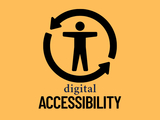The Art of the Description: How to Write Alt Text for Everyone
Write better image descriptions with 5 simple tips
In a world of digital-content, images are often a key part of how we communicate. For students who use screen readers, a picture isn't worth a thousand words -- unless it has effective alt text. Alt text for images isn't just about checking an accessibility box; it's about making sure everyone, including people with disabilities, can access and understand your content. By writing alt text that focuses on an image's purpose, you remove unseen barriers and make your course materials more inclusive for all.
Whether you're teaching, designing, or sharing visuals online, here are five ways to level up your image accessibility.
1. Write for Purpose, Not Perfection
What's the point of the image? Start there. Are you introducing a concept, reinforcing a message, or providing a visual example? Don't describe every pixel -- alt text is most effective when it's tied to the image's purpose, not just its appearance. An instructor's headshot just needs to be "Professor Henry Jones, smiling" not "A photo of a smiling middle-aged man with brown hair wearing a tweed suit, standing in a room with floor-to-ceiling books."
2. Say What You See
Screen readers already announce it's an image. Instead of starting with "Photo of a student," get to the point: "Student smiles while presenting a final project to classmates." Only mention format if it matters -- for example, "A bar chart showing enrollment growth from 2018–2024."
3. Context Is Key: Platform, People, Purpose
Your description should reflect the audience and platform. While alternative text for an image on social media might be conversational and brief; the same image in a course module might need more detail. Think about what your audience already knows, and what they need you to describe.
- Social Media: An image on Instagram or myUMBC showing students protesting on campus may say, "A crowd of U-M-B-C students fills the Quad in March 1981, holding handmade protest signs to show support for keeping the university open."
- Course Module: The same image in a history course's syllabus could be "Black-and-white photo originally printed in The Baltimore Sun showing a crowd of U-M-B-C students gathered in protest on campus in March 1981. The students' serious expressions and visible determination reflect their opposition to a proposed plan to shut down the campus."
4. Not All Images Need Alt Text
If an image is purely decorative -- like a border, divider, or flourish -- mark it as decorative so screen readers skip it. In many content editors, including Blackboard and Sites@UMBC, you can select an option to mark an image as decorative, which tells screen readers to skip it. However, if the image adds meaning or helps a student understand the content, it deserves a description.
5. Try Ally or AI for a Head Start
Use your Ally course report or individual Ally meters in Blackboard to find images missing alt text. You can also try Ally's AI Alt Text Assistant or Google Gemini to generate a description -- but always review and revise for accuracy, tone, and clarity. AI is a great starting point as a first draft for descriptions. It gets you 80% of the way there, but as the subject matter expert, you're the one who will make it perfect.
Ready to take the first step?
- If you'd like to learn more about making images more accessible, please sign up for Accessible Images: Basics of Alt Text & Decorative Images on October 10.
- Visit UMBC’s Digital Accessibility site or run an Ally course report today.
- Support is also available from Student Disability Services and Instructional Technology.
Additional Resources
--
Content adapted from the images workshop at the June 2025 Digital Accessibility Summer Camp (Theresa Mabe).
Posted: October 9, 2025, 9:36 AM
